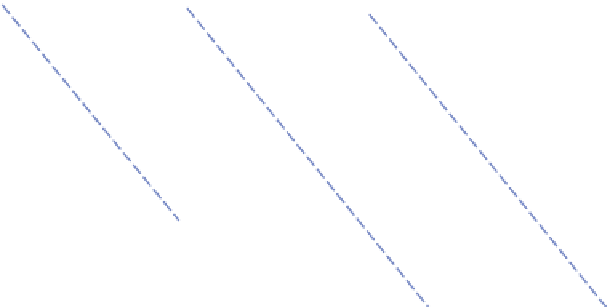Geoscience Reference
In-Depth Information
precipitation belt in the forward sector of the
storm can affect a locality in its path for 6 to 12
hours, whereas the belt in the rear gives a shorter
period of thunderstorm-type precipitation. These
sectors are therefore sometimes distinguished in
precipitation classifications, and a more detailed
breakdown is illustrated in
Table 9.2
. Polar
lows (see Chapter 9H.3) combine the effects of
airstream convergence and convective activity of
category 2 (previous section), whereas troughs in
the equatorial low pressure area give convective
precipitation as a result of airstream convergence
in the tropical easterlies (see Chapter 13B.1).
may produce several effects depending on its
alignment and size. They include: (1) forced ascent
on a smooth mountain slope, producing adiabatic
cooling, condensation and precipitation; (2)
triggering of conditional or convective instability
by blocking of the airflow and upstream lifting; (3)
triggering of convection by diurnal heating of
slopes and up-slope winds; (4) precipitation from
low-level cloud over the mountains by 'seeding' of
ice crystals or droplets from an upper-level feeder
cloud (
Figure 5.14
); and (5) increased frontal
precipitation by retarding the movement of
cyclonic systems and fronts. West coast mountains
with onshore flow, such as the Western Ghats,
India, during the southwest summer monsoon; the
west coasts of Canada, Washington and Oregon;
or coastal Norway in winter months supposedly
illustrate smooth, forced ascent, yet many other
processes seem to be involved. The limited width
of some coastal ranges, with average wind speeds,
generally allows insufficient time for the basic
mechanisms of precipitation growth to operate
(see
Figure 4.9
). In view of the complexity of
3 Orographic precipitation
Orographic precipitation is commonly regarded as
a distinct type, but this requires careful quali-
fication. Mountains are not especially efficient in
causing moisture to be removed from airstreams
crossing them, yet because precipitation falls
repeatedly in more or less the same locations, the
cumulative totals are large. An orographic barrier
Pre-existing seeder cloud
SEEDING PRECIPITATION
MOIST
Feeder cloud
OROGRAPHIC
ENHANCEMENT
LOW-LEVEL
FLOW
Figure 5.14
Schematic diagram of T. Bergeron's 'seeder-feeder' cloud model of orographic precipitation
over hills.
Note: This process may also operate in deep nimbostratus layers.
Source: After Browning and Hill (1981), by permission of the Royal Meteorological Society.





































